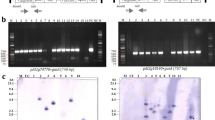Abstract
The goal of this study was to assess the susceptibility of the nematode resistance gene, Mi-1.2, to transgene inactivation. The stability of Mi-mediated nematode resistance and Mi-1.2 transcripts levels was observed in two independently transformed tomato lines carrying Mi-1.2. In both lines a reduction in resistance was noted in the T2 generation, and was more pronounced in the T3 generation. The decrease in resistance varied among cuttings that were clonally propagated, which suggests that resistance levels were influenced by epigenetic effects. The transgenic plants, however, did not show the reduced transcript levels characteristic of gene silencing or negative position effects. RNase protection assays revealed that Mi-1.2 mRNA levels in the transgenic plants were comparable to levels observed in resistant control plants, and there was no correlation between transcript levels and resistance levels among the transgenic plants. Reductions in nematode resistance could be due to silencing of other endogenous gene(s) involved in resistance. Alternatively, these reductions could be caused by previously uncharacterized mechanisms of transgene inactivation that target the Mi-1.2 protein or block its production.
Similar content being viewed by others
References
De Wilde C., Van Houdt H., De Buck S., Angenon G., De Jaeger G. and Depicker A. 2000. Plants as bioreactors for protein pro-duction: avoiding the problem of transgene silencing. Plant Mol. Biol. 43: 347–359.
Dropkin V.H. 1969. The necrotic reaction of tomatoes and other hosts resistant to Meloidogyne: reversal by temperature. Phyto-pathology 59: 1632–1637.
Dunsmuir P., Bond D., Lee K., Gidoni D. and Townsend J. 1987. The expression of introduced genes in regenerated plants. In: Gelvin S. and Schilperoort R. (eds), Plant Molecular Biology Manual. Plenum Press, New York, New York, USA, pp. 45–59.
Elmayan T. and Vaucheret H. 1996. Expression of single copies of a strongly expressed 35S transgene can be silenced post-transcriptionally. Plant J. 9: 787–797.
Fagard M. and Vaucheret H. 2000. (Trans)gene silencing in plants: how many mechanisms? Annu. Rev. Plant Physiol. Plant Mol. Biol. 51: 167–194.
Finnegan J. and McElroy D. 1994. Transgene inactivation: plants fight back! Bio/Technol. 12: 883–888.
Fire A. 1999. RNA-triggered gene silencing. Trends Genet. 15: 358–363.
Goggin F.L., Williamson V.M. and Ullman D.E. 2001. Variability in the Response of Macrosiphum eupuorbiae and Myzus persi-cae (Hemiptera: Aphididae) to the tomato resistance gene Mi. Environ. Entomol. 30: 101–106.
Kumpatla S.P., Chandrasekharan M.B., Iyer L.M., Li G. and Hall T.C. 1998. Genome intruder scanning and modulation systems and transgene silencing. Trends Plant Sci. 3: 97–104.
Lambert K.N., Tedford E.C., Caswell E.P. and Williamson V.M. 1992. A system for continuous production of root-knot nematode juveniles in hydroponic culture. Phytopathology 82: 512–515.
Melton D.A., Krieg P.A., Rebagliati M.R., Maniatis T., Zinn K. and Green M.R. 1984. Efficient in vitro synthesis of biologically ac-tive RNA and RNA hybridization probes from plasmids contain-ing a bacteriophage SP6 promoter. Nucleic Acids Res. 12: 7035–7056.
Matzke A.J.M. and Matzke M.A. 1998. Position effects and epige-netic silencing of plant transgenes. Current Opinion in Plant Bi-ology 1: 142–148.
Meyer P. 1995. Understanding and Controlling transgene expres-sion. Trends Biotech. 13: 332–337.
Milligan S.B., Bodeau J., Yaghoobi J., Kaloshian I., Zabel P. and Williamson V.M. 1998. The root knot nematode resistance gene Mi from tomato is a member of the leucine zipper, nucleotide binding, leucine-rich repeat family of plant genes. Plant Cell 10: 1307–1319.
Roberts P.A., May D. and Matthews W.C. 1986. Root-knot nema-tode resistance in processing tomatoes. California Agriculture 40: 24–26.
Roberts P.A. and Thomason I.J. 1986. Variability in reproduction of isolates of Meloidogyne incognita and M.javanica on resis-tant tomato genotypes. Plant Disease 70: 547–551.
Walden R. and Wingender R. 1995. Gene-transfer and plant-regen-eration techniques. Trends Biotech. 13: 324–331.
Williamson V.M. and Hussey R.S. 1996. Nematode pathogenesis and resistance in plants. Plant Cell 8: 1735–1745.
Yaghoobi J., Kaloshian I., Wen Y. and Williamson V.M. 1995. Mapping a new nematode resistance locus in Lycopersicon pe-ruvianum. Theor. Appl. Genet. 91: 457–464.
Author information
Authors and Affiliations
Corresponding author
Rights and permissions
About this article
Cite this article
Goggin, F.L., Shah, G., Williamson, V.M. et al. Instability of Mi-mediated nematode resistance in transgenic tomato plants. Molecular Breeding 13, 357–364 (2004). https://doi.org/10.1023/B:MOLB.0000034090.73857.b1
Issue Date:
DOI: https://doi.org/10.1023/B:MOLB.0000034090.73857.b1




